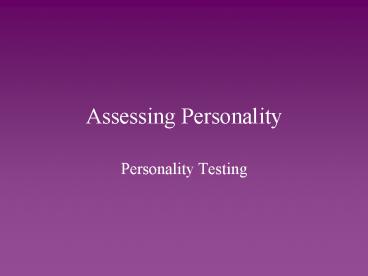Assessing Personality - PowerPoint PPT Presentation
1 / 19
Title:
Assessing Personality
Description:
Assessing Personality Personality Testing Psychological Testing Psychological tests assess a person s abilities, aptitudes, interests or personality based on a ... – PowerPoint PPT presentation
Number of Views:200
Avg rating:3.0/5.0
Title: Assessing Personality
1
Assessing Personality
- Personality Testing
2
Psychological Testing
- Psychological tests assess a persons abilities,
aptitudes, interests or personality based on a
systematically obtained sample of behavior. - 2 Basic Goals
- Accurately consistently reflect a persons
characteristics on some dimension. - Predicts a persons future psychological
functioning or behavior.
3
Personality Assessment
- Projective Techniques
- Interpretation of an ambiguous to trigger
projection of ones inner thoughts and feelings - Used to determine unconscious motives, conflicts,
and psychological defenses traits
4
Rorschach Inkblot Test
- Presentation and interpretation of a series of
black and white and colored inkblots - Developed in 1921.
- Personality test that seeks to identify peoples
inner feelings by analyzing their interpretations
of 10 inkblots - Numerous scoring systems exist
5
(No Transcript)
6
Thematic Apperception Test
- Series of pictures depicting ambiguous scenes
- Subject is asked to create a story about the
scene - Answers are scored based on themes, motives, and
anxieties of main character
7
(No Transcript)
8
Drawbacks to Projective Tests
- Examiner or test situation may influence
individuals response - Scoring is highly subjective
- Tests fail to produce consistent results
(reliability problem) - Tests are poor predictors of future behavior
(validity problem)
9
Testing for TraitsSelf-Report Inventories
10
Personality Inventories
- Questionnaires on which people respond to items
designed to gauge a wide range of feelings and
behaviors - Used to assess selected personality traits
- Often true-false, agree-disagree, etc. types of
questions - Persons responses to standardized questions are
compared to established norms.
11
Validity
- The extent to which a test measures or predicts
what it is suppose to test - Personality inventories offer greater validity
than do projective tests (e.g. Rorschach used by
proponents of the humanistic perspective).
12
Reliability
- The extent to which a test yields consistent
results, regardless of who gives the test or when
or where it is given - Personality inventories are more reliable than
projective tests.
13
MMPI
- Minnesota Multiphasic Personality Inventory
(MMPI) - Most clinically-used personality test
- 500 total questions
- Originally designed to assess abnormal behavior
14
MMPI Scoring Profile
15
MMPI-2
- Revised and updated version of the MMPI
- Assesses test takers on 10 clinical scales and 15
content scales - Sometimes the MMPI-2 is not used as it was
intended.
16
Other Self-Report Inventories
- California Personality Inventory (CPI) assesses
personality characteristics in normal
populations. - Sixteen Personality Factor Questionnaire (16 PF)
Cattells test that creates a personality
profile on 16 trait dimensions.
17
Testing for Careers
- Play Personality Testing for Career Choice
(359) Segment 28 from Psychology The Human
Experience.
18
Strengths of Self-Reports
- Standardizedeach person receives same
instructions and responds to the same questions - Use of established norms results are compared to
previously established norms and are not
subjectively evaluated - Greater reliability and validity than projective
tests.
19
Weaknesses of Self-Reports
- Evidence that people can fake responses to look
better (or worse) - Some people are prone to responding in a set way,
whether the item accurately reflects them or not. - Tests contain hundreds of items and become
tedious - People may not be good judges of their own
behavior

